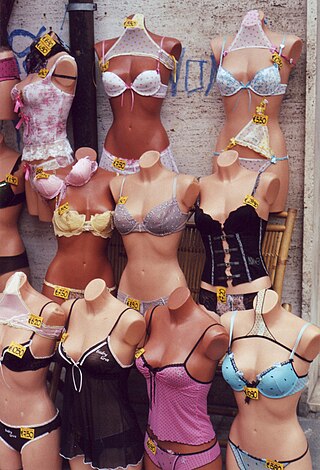Related Research Articles

Lingerie is a category of primarily women's clothing including undergarments, sleepwear, and lightweight robes. The choice of the word is often motivated by an intention to imply that the garments are alluring, fashionable, or both. In a 2015 US survey, 75% of women reported having worn "sexy lingerie" in their lifetime.

Frederick's of Hollywood is an American lingerie brand formerly with stores in shopping malls across the United States. In 2015, all 111 retail stores were closed before a bankruptcy filing. The brand was acquired by Authentic Brands Group and was relaunched as an online-only store, FOH Online Corp. In 2018, Naked Brand Group, Inc. acquired FOH Online Corp.

A nursing bra is a specialized brassiere that provides additional support to women who are lactating and permits comfortable breastfeeding without the need to remove the bra. This is accomplished by specially designed bra cups that include flaps which can be opened with one hand to expose the nipple. The flap is usually held closed with a simple clasp or hook.

Cleavage is the narrow depression or hollow between the breasts of a woman. The superior portion of cleavage may be accentuated by clothing such as a low-cut neckline that exposes the division, and often the term is used to describe the low neckline itself, instead of the term décolletage. Joseph Breen, head of the U.S. film industry's Production Code Administration, coined the term in its current meaning when evaluating the 1943 film The Outlaw, starring Jane Russell. The term was explained in Time magazine on August 5, 1946. It is most commonly used in the parlance of Western female fashion to refer to necklines that reveal or emphasize décolletage.

The history of bras is closely tied to the social status of women, the evolution of fashion, and shifting views of the female body over time.

Bra size indicates the size characteristics of a bra. While there is a number of bra sizing systems in use around the world, the bra sizes usually consist of a number, indicating the size of the band around the woman's torso, and one or more letters that indicate the breast cup size. Bra cup sizes were invented in 1932 while band sizes became popular in the 1940s. For convenience, because of the impracticality of determining the size dimensions of each breast, the volume of the bra cup, or cup size, is based on the difference between band length and over-the-bust measurement.

Ultimo was a Glasgow-headquartered designer lingerie brand, majority owned by Sri Lanka–based lingerie group MAS Holdings. It was founded in 1996 by Michelle Mone, via her company MJM International Ltd., with her then-husband Michael. In 2013, after their marriage collapsed, Ultimo was transferred to joint venture company Ultimo Brands International Ltd, an equal partnership between Michelle Mone and MAS Holdings. In November 2014, Mone sold the majority of her stake to MAS Holdings. In August 2015, Mone resigned from the boards of MJM International Ltd and Ultimo Brands International Ltd.

A back closure is a means for fastening a garment at the rear, such as with a zipper, hooks-and-eyes or buttons. Back closures were once common on Western female clothing, but have recently become less so, especially on female casual and business attire. They continue, however, to be widely used in underwear, formal wear and specialized clothing. Back closures are also common in garments for infants and toddlers.
A bra, short for brassiere or brassière, is a form-fitting underwear that is primarily used to support and cover a woman's breasts. A typical bra consists of a chest band that wraps around the torso, supporting two breast cups that are held in place by shoulder straps. A bra usually fastens in the back, using a hook and eye fastener, although bras are available in a large range of styles and sizes, including front-fastening and backless designs. Some bras are designed for specific functions, such as nursing bras to facilitate breastfeeding or sports bras to minimize discomfort during exercise.

A training bra is a lightweight brassiere designed for girls who have begun to develop breasts, at Tanner stage II and III. The training bra is intended to be worn during puberty when the breasts are not yet large enough to fit a standard-sized bra. Training bras often provide minimal or no support, and may serve aesthetic purposes to fulfill cultural norms and local beauty standards.

Underwear, underclothing, or undergarments are items of clothing worn beneath outer clothes, usually in direct contact with the skin, although they may comprise more than a single layer. They serve to keep outer clothing from being soiled or damaged by bodily excretions, to lessen the friction of outerwear against the skin, to shape the body, and to provide concealment or support for parts of it. In cold weather, long underwear is sometimes worn to provide additional warmth. Special types of undergarments have religious significance. Some items of clothing are designed as undergarments, while others, such as T-shirts and certain types of shorts, are appropriate both as underwear and outerwear. If made of suitable material or textile, some underwear can serve as nightwear or swimwear, and some undergarments are intended for sexual attraction or visual appeal.

Gossard is a Nottingham-based brand and manufacturer of women's undergarments and hosiery. Founded in the early 20th century in Chicago as H. W. Gossard Co., it expanded quickly, flourishing in the 1920s. As Associated Apparel Industries, Inc. it held a central position in its market in the 1930s. Amalgamated eventually succumbed to the poor economy in the United States during the Great Depression, but Gossard continues as a division of Courtaulds in Great Britain.

Wearing underwear as outerwear is a fashion trend popularized by celebrities, sports and media. It began as a practical and comfortable variation of clothing, such as the T-shirt and the sleeveless shirt, but later evolved into provocative, controversial fashion statements. 21st century versions include the display of thongs and bras in women's clothing, and the display of underpants under low-slung pants in men. Wearing underwear as outerwear has historical antecedents in the display of undergarments in the sixteenth and seventeenth centuries.

Kay Cohen is an Australian fashion designer and business woman based in Sydney, Australia. Cohen has led a number of lingerie design brands, most notably as Founder and Creative Director of Pleasure State and as General Manager and Creative Director of Elle Macpherson's Lingerie label Elle Macpherson Intimates, also Cohen is known as the inventor of the Biofit uplift bra.
Nubian Skin is a London-based English lingerie and hosiery brand launched in 2014 by Ade Hassan, specializing in "nude" undergarments for women of colour.
Adetola Kunle-Hassan,, known as Ade Hassan, is a British businesswoman who founded Nubian Skin in 2014.
Exquisite Form is an American clothing brand for women's intimates, particularly bras and shapewear for full-figured women. The brand is owned by Vanity Fair Brands, a division of Fruit of the Loom.
Lastex is a type of elastic yarn that was introduced in the 1930s and was primarily used for swimwear, brassieres, girdles and corselettes. It consists of a rubber core surrounded by wool, rayon, silk or cotton threads. It was invented and distributed by the Adamson Brothers, a company owned by the US Rubber Company. It entered the market in 1931.
Thousands of years of history provide evidence of the differing fashions, cultural norms, and artistic depictions regarding cleavage and clothes that accentuate or flaunt cleavage. From the absolute modesty of the 16th century, to the Merveilleuses Directoire dresses with their transparency, the décolleté has followed the times and is much more than a simple fashion effect.
References
- ↑ "Bra, Kestos 1364421 | National Trust Collections". nationaltrustcollections.org.uk. Retrieved 8 July 2015.
- ↑ "The Sydney Morning Herald - Google News Archive Search" . Retrieved 8 July 2015.
- ↑ "Vintage Bras Inspire Modern Lingerie Designers on Lingerie Briefs". lingeriebriefs.com. 4 February 2013. Retrieved 8 July 2015.
- ↑ "Where oh where is the underwear?". Independent.co.uk . 28 August 1997.
- ↑ "100 years of the BRA; WE INVITE YOU TO RAISE YOUR CUPS AND TOAST.. - Free Online Library". thefreelibrary.com. Retrieved 8 July 2015.
- ↑ Conference paperiffti.com Archived 2 February 2014 at the Wayback Machine
- ↑ "Hoorah for the bra!". smh.com.au. 8 May 2013. Retrieved 8 July 2015.
- ↑ "Partial Coverage - The Kestos Brasierre: The First Of Its Kind". dollhousebettie.com. Retrieved 8 July 2015.
- ↑ Pauline Thomas. "Bra History - Bras and Girdles - A Fashion History". fashion-era.com. Retrieved 8 July 2015.
- ↑ "100 Years of the Bra". Mirror Online. 9 April 2007. Retrieved 8 July 2015.
- ↑ Lauren Olds (2001). "World War II and Fashion: The Birth of the New Look". Constructing the Past. 2 (1).
- ↑ "The New Yorker Digital Edition : Dec 07, 1935". archives.newyorker.com. Retrieved 8 July 2015.
- ↑ "Museum of London Blog Is that Aristoc or Kira sheer? » Museum of London Blog". blog.museumoflondon.org.uk. Archived from the original on 3 December 2013. Retrieved 8 July 2015.
- ↑ Farrell-Beck, J.; Gau, C. (2002). Uplift: The Bra in America. University of Pennsylvania Press, Incorporated. p. 78. ISBN 9780812218350 . Retrieved 8 July 2015.